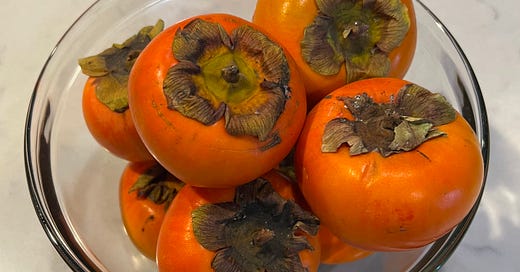Education's Invisible Garden
The circadian rhythm of school and the quiet productivity of winter
I’ve always wanted to be a persimmon burglar. Walking around neighborhoods in late summer, identifying houses with budding, green fruit, logging them in a notebook, and plotting the friendliest fall heist months later. I’d never take all of them from a tree. That’s absurd. I’d just take a few here and there under the cover of darkness, whisper a quiet “Thank you!” and move on to the next.
I just don’t have the stone fruit to actually infiltrate yards and take from thy neighbor. So, grocery store it is.
Persimmons have always signaled to me that the school year is in its dreary phase. Late fall and winter. I love both fuyu (squat, pumpkin-like) and hachiya (long, droopy-like) persimmons. When I start to see them around, it’s the time of year where weekend grocery shopping happens in that 83-minute sliver of daylight in between darkness, and anything resembling energy after school is hidden beneath sweatpants. Lessons are notches that get us closer to December break, and the end of the year is miles to go before we sleep, miles to go before we sleep.
The school year has a circadian rhythm. The auburn energy of fall. The gray, cold winter. The crisp, green transition of spring. The yellow heat of summer. With each of those seasons comes a different way of being in school, a different ability to take in information, and a different ability to engage with others. We respond to the seasons of the school year much like we respond to the seasons of the calendar year.
As administrators manage adults, as teachers manage students, it’s important to note those rhythms. There are times where students can handle more, and there are times where they can’t. There are times where educators are more alert, more ready for change, and there are times where we just need to get to 3:30pm one more time. Those dark days are just as important as the others. They all can’t be energy-laden, vigorous champions of a day. Winter serves a purpose.
Spring isn’t spring without something to spring from. Rest is productive.
I always let persimmons sit at least a few days after I buy them. I want them to continue to do their magic. I want them to get sweeter and softer before I enjoy the, well, fruit of nature’s sugar harvest that has been in process since early spring; when I first notice the green buds in summer is already long after the tree has started its work. Nature works quietly, invisibly.
I eat fuyus like an apple, but I let hachiyas sit until they get wrinkly-soft and are ready to spread like jam. If you were to see it on the kitchen counter, you’d think I forgot about it. And you’d be so wrong. I observe the oblong shape everyday, watching the wrinkles multiply slowly, sometimes picking it up to test its give. I wait for it to feel like it’s ready to tear at the slightest touch. Only then do I know that the sugars have done their job, that the fruit is ready to lie down gently on toast. Arriving at that wrinkled ripeness is a quiet process, but it’s a process that has me engaged throughout.
Learning is the same. Lessons take time, and the deepest ones bud long after graduation. Ah-ha moments are powerful, of course. And, individual lessons bring immediate insight. The true fruit of learning, though, takes time to develop. It takes time to establish roots of understanding in the soil of experience, and educators are rarely there when it germinates.
Education is an invisible garden.
That garden needs to be tended to differently at different times. At times, the soil needs to be tilled in order to ready it for new lifecycles. Teaching practices need injections of innovations in order to better meet students where they are. Meetings need different structures to shake off the stagnation of expectation. Even new locations can freshen things up. A walking meeting can aerate the conversation and allow for more fruitful conversation than staring at a shared agenda on Google Docs.
It’s the winter solstice today— the shortest day of the year. Under the cover of darkness, though, educators are making room for a robust spring of second-semester instruction. Those lessons, those projects may yield buds of learning in the moment, but the true harvest of education will be collected long after.
Get that rest. It’s productive.







Holy writing!
Very compelling and well-structured. I am taking notes, Mr. Exemplar.
The discussion about Persimmons brings me back to my days in Japan. I too recognized the consumption of them as the dreary time of year outside.